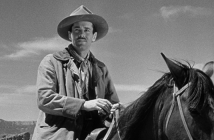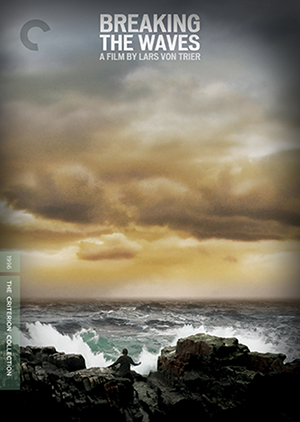Cast: Tetsurô Tanba, Isamu Nagato, Mikijiro Hira
Director: Hideo Gosha
Country: Japan
Genre: Action | Drama
Official Trailer: Here
Purchase Now!
For Gosha Hideo’s magnificent debut feature film Three Outlaw Samurai (1964), released by Criterion on DVD and Blu-ray February 14th, he adapted his television series of the same title (which debuted the year before) and cast the three male leads of the series’ first season as the titular samurai: Tamba Tetsuro, Hara Mikijiro, and Nagato Isamu. In a brisk running time of ninety-three minutes, Gosha delivers no less than a kind of searing manifesto on his stance vis-à-vis myths that surround and constitute the samurai—honour, duty, loyalty—and vis-à-vis representations of samurai in cinema. In turn, he directly addresses issues of class, protest, and empathy, only to wrest from them their elevated clothing, wrestle them to the ground, and see what happens to them when they get mud on them, alongside the samurai and the hierarchy he represents, all in glorious widescreen.
In a brisk running time of ninety-three minutes, Gosha delivers no less than a kind of searing manifesto on his stance vis-à-vis myths that surround and constitute the samurai…
It is perhaps no surprise that the well-known opening credits sequence of Three Outlaw Samurai is of a samurai’s feet trudging through sticky, thick mud. For those already familiar with Gosha’s cinema, including his sophomore effort Sword of the Beast (1965)—also out on Criterion—animalism is a crucial aspect of Gosha’s characterisation of samurai. As the still yet unknown samurai continues his walk through a muddy path in the beginning of Three Outlaw Samurai, a dog appears from a corner of a field. Then a little later, a man on his hands and knees does the same. This unassuming comparison of man and dog will persist in the rest of the film, not only in terms of action but also in terms of dialogue, as the words ‘dog,’ ‘stray dog,’ and even ‘kennel’ will be used by characters to describe what they are witnessing at the moment.
 This unknown ronin, or masterless samurai, at the outset is Shiba Sakon (Tamba). He eventually comes upon a mill, inside of which he encounters three peasants holding hostage a woman above their class. When they reveal to him that they are holding her hostage in order to negotiate the reduction of taxes imposed by her father the magistrate, Shiba decides to actively take the side of the peasants. And with that, the first half of the film begins, limited to the interior settings of the mill and the magistrate’s palace but brilliantly executed with tension, uncertainty, and a contradictory energy. Throughout the day and night, the magistrate sends jailed criminals and samurai to the mill in exchange for resolving the issue with these three peasants. In this way, Gosha leaves suspended the identities of the three samurai who will constitute those referenced in the title—regardless of whom Tamba, Hira, and Nagato play. This detail is important to the narrative’s dynamism; it blurs the lines between criminal, samurai, careerist, magistrate, and later on, lord and challenges the hierarchical non/value attributed to each type. This blurring becomes further exacerbated as the film progresses because characters will change or hesitate to pick sides. What of the samurai Sakura Kyojuro (Nagato), one of the criminals jailed by the magistrate and sent to kill the three peasants and Shiba? What of Kikyo (Hira), who appears to care more about his place in the palace and going to the brothel? Or could it be the set of three samurai whom the magistrate recruits to put an end to the three peasants?
This unknown ronin, or masterless samurai, at the outset is Shiba Sakon (Tamba). He eventually comes upon a mill, inside of which he encounters three peasants holding hostage a woman above their class. When they reveal to him that they are holding her hostage in order to negotiate the reduction of taxes imposed by her father the magistrate, Shiba decides to actively take the side of the peasants. And with that, the first half of the film begins, limited to the interior settings of the mill and the magistrate’s palace but brilliantly executed with tension, uncertainty, and a contradictory energy. Throughout the day and night, the magistrate sends jailed criminals and samurai to the mill in exchange for resolving the issue with these three peasants. In this way, Gosha leaves suspended the identities of the three samurai who will constitute those referenced in the title—regardless of whom Tamba, Hira, and Nagato play. This detail is important to the narrative’s dynamism; it blurs the lines between criminal, samurai, careerist, magistrate, and later on, lord and challenges the hierarchical non/value attributed to each type. This blurring becomes further exacerbated as the film progresses because characters will change or hesitate to pick sides. What of the samurai Sakura Kyojuro (Nagato), one of the criminals jailed by the magistrate and sent to kill the three peasants and Shiba? What of Kikyo (Hira), who appears to care more about his place in the palace and going to the brothel? Or could it be the set of three samurai whom the magistrate recruits to put an end to the three peasants?
…it blurs the lines between criminal, samurai, careerist, magistrate, and later on, lord and challenges the hierarchical non/value attributed to each type.
As the standoff between the three peasants, with Shiba, and the magistrate’s hired henchmen prolongs itself, more and more characters enter the fray. The magistrate’s logic is as follows: kill the peasants and then kill the killers. The process becomes an increasingly bigger vicious cycle and hardly anyone succeeds in escaping it. To visualise this sense of a snare and vicious circle, Gosha populates the film with shots and scenes of characters blocked by wooden bars, be it looking from the mill outside or vice-versa, looking from an entrance, or looking from an actual cell. The result is a sequestered atmosphere that ensnares every level of class and sub-class within the palace and surrounding area and witnesses men and women dash between the mill and palace as they change or pick alliances, or even betray them. The mill and the palace emerge as two magnets of power attracting and repelling each other, one seeking grievances and the other seeking a good face to present to the lord who will be arriving, but often bleeding into each other.
The second half of the film is about exteriors: the fights between the three outlaw samurai and the magistrate’s men tumble outdoors and into open fields. The film comes full circle in the end, as the three outlaw samurai come to replace the three peasants, in a way, and realise that all the blood, pain, and loss that they have just endured lost its objective in the process of the fight.
As melancholy as it sounds, Three Outlaw Samurai trembles with a cinematic, widescreen vibrancy and efficiency that is breathtaking. Of especial note is Tamba, who also co-produced the film. As Shiba, he is a formidable presence that anchors the film’s multiple sides, trajectories, and desires. Though less well-known compared to the likes of Mifune Toshiro and Nakadai Tatsuya, Tamba gives a magnetic and understated performance that should be recognised alongside the above-named actors in the genre.
DVD Extras
The extras are rather slim, but the importance of making accessible the beginnings of Gosha’s startling cinema is massive. Film critic Bilge Ebiri’s essay included in the DVD booklet provides a wonderful introduction to Gosha’s cinema and significance. The trailer included in the DVD is a rather interesting two minutes of scenes that do not appear in the finished film; some of the scenes include Gosha himself interacting with his actors and crew. Also interesting about the trailer is that it is conscious about the animalistic nature of Gosha’s characters, with the voiceover employing the words ‘dogs’ and ‘wolves’ to describe the film.
[notification type=”star”]93/100 ~ AMAZING. Though less well-known compared to the likes of Mifune Toshiro and Nakadai Tatsuya, Tamba gives a magnetic and understated performance that should be recognised alongside the above-named actors in the genre.[/notification]


